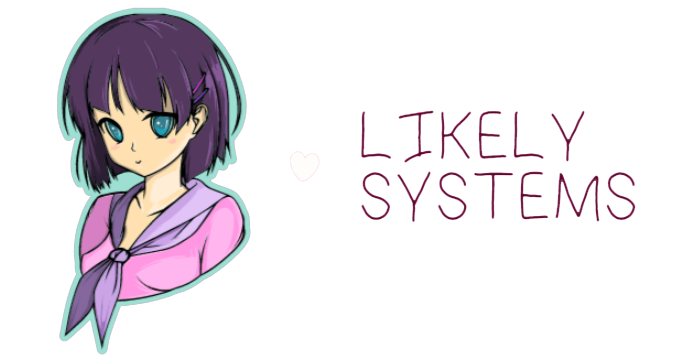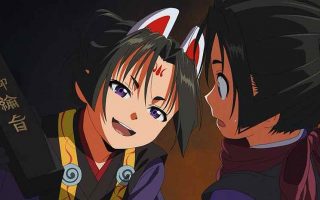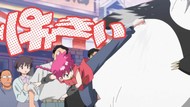Phoenix’s first volume took us back to the dawn of Japanese history, detailing the selfish ambitions and overwhelming violence of the island’s origins, how “Japan was formed as a nation through invasion, war, and slaughter.” Its second volume sped forward to the end of human history, offering a vision of the future where our shortsightedness and distrust of the Other led to the destruction of not just our species, but life on earth altogether. Though the phoenix itself embodies hope of a better way, that hope is clearly a distant one; for as Tezuka has continuously demonstrated, individual acts of charity or enlightenment cannot halt the overall tide of tribalism, indolence, and desperation for personal glory that seems to define our greater nature.
Even to frame us as no different than the beasts of the land seems to give us too much credit in Tezuka’s eyes. Beasts may struggle for survival, but they do not seek eternity to the detriment of life altogether. They live for a time and then pass from this earth, embodying a grace and unconscious understanding of life’s cycles that Tezuka sees as the essence of fruitful coexistence, the only way to find peace with the horror of facing mortality. Our sentience is its own sort of curse; for as we are blessed with the ability to reason and dream, so too are we burdened with the terror of nonexistence, the urge to maintain our flame that prompts us to hunt the phoenix.
Tezuka’s time-hopping approach echoes the scope of his work’s perspective. Like the phoenix itself, the text maintains no particular loyalty or sympathy towards any individual human; it is humanity at large that is the work’s priority, as it seeks to find a path beyond the provincial selfishness of our individual nature to arrive at a credo of humanity that can stand through time, that can actually guide us towards a sustainable and mutually supportive future. To see any one human as the “protagonist,” the figure who must succeed if we are to achieve a happy ending, would be to fall into the same trap of Phoenix’s individual characters. We must let go of our self-oriented perspective if we are to succeed, just as Tezuka himself does.
Or at least, just as Tezuka attempts to. For even he admits that every story we tell of ourselves is an act of interpretation, a comfortable sorting of complex individuals into their most heroic or villainous aspects. Volume three’s tale of the King of Yamato opens with a self-effacing acknowledgment that Tezuka’s proposal is simply one hypothesis of his life, and later on, Yamato himself complains that his rival Takeru’s sister Kajika gets far too much panel space. Every history is a work of interpretation, and every choice made in constructing such a history implies specific priorities and biases, an authorial belief in the primacy of some information over other potential topics.
At this point, Tezuka’s mastery of his own visual language is so pronounced that he can actively interrogate the assumptions made by his own text, critiquing the implications inherent in how one or another character is visually represented. It is not just the facts, but the nature of the telling that defines a story’s moral and political intent, as his playful shifting of Kajika’s visual identity demonstrates. Tezuka well understands that there is no objective record of history as written by man, and is happy to condemn himself alongside Yamato, so long as that results in his audience understanding the inherent trickery of allegedly unbiased historical records.
Volume three’s first half is consumed with such thoughts of eternity, as the tyrant Yamato and his rival Takeru battle over their right to dictate the first records of Japan. The contrast between Yamato’s true, bizarre visual form and his desire for a glorious, flattering historical chronicle embodies the contradiction of our profoundly small, isolated individual glories and our desire to make a lasting mark on history, to live forever if only in legend.
Even if our legends survive, they are clearly not an accurate account of the historical record – and of course, the “historical record” is itself a flattering human invention, containing within it an implication that the actions of powerful leaders are inherently important and worthy of record, in contrast with the apparently insignificant lives and actions of those who toil beneath them. Any true accounting of Yamato’s reign would emphasize the cruelty of his dictates as well as the beauty of his land and people, but Yamato wants to be flattered and idealized, not held to account for who he truly was. Our self-images may never be compatible with the reality of our existence; perhaps that too is intrinsic to humanity.
Outraged by the thought of a historical chronicle that does not center his own perspective, Yamato sends his rebellious son Oguna to assassinate rival chronicler Takeru. This does not turn out how any of them expected; Oguna swiftly comes to respect Takeru and love his sister Kajika, and seeks the phoenix of their land only so that he might save the innocents condemned as sacrifices to his father’s glory. Caught between family and love, Oguna receives wisdom from the still-living son of Em Dee, who tells him that “just staying alive won’t bring you happiness. The most important thing is to find out what your purpose is while you’re here on earth.” Oguna takes this advice home with him, exploiting his position to turn his father’s grand tomb into a playground, expending his influence in such a way that others might actually benefit from his chosen purpose.
In contrast, the pathetic waste that Yamato made of his life is only clear to him as death approaches, and he realizes he’s created nothing of genuine merit. In the end, no act of self-satisfaction will make up for the banal emptiness of a wasted life, a life spent only in pursuit of personal glory. In the face of death, our attempts to present ourselves as legends who will outlast all others are revealed for the foolish notions that they are. Death is the great equalizer, and as Phoenix has repeatedly demonstrated, those who rage most desperately against the dying of the light are often those who are least prepared for it when it comes. You must make peace with death and find a meaningful purpose in life, if for no other reason than the fact that death will always eventually find you.
While volume three’s first story is a direct continuation of its predecessors’ themes, its space-age successor seems more like a playground for Tezuka’s visual experimentation, as Tezuka pursues what he clearly believes to be his own life’s purpose. Even in the Yamato section, Tezuka’s experimentation is more ambitious and vivid than ever, whether it’s through his transposing the musical concept of leitmotifs to paneling in order to build up a visual vocabulary of emotional resonances (as in his repeated use of sun ray panels associated with the phoenix itself), or simply through individual acts of bravura paneling (as when a massive tree is used as visual grounding for half a dozen separate panels, evoking the paneling equivalent of a cinematic match cut).
In Space, the fairly straightforward conflict of a mysterious murder aboard a spacecraft provides an easy template for further experimentation. From the beginning, Tezuka is already reinventing the rules of paneling, using gutters as arrows to draw the audience through simultaneous sequences of action, emphasizing comic pages’ unique ability to convey simultaneous actions by partitioning them in different parts of the page. And it feels so graceful, too – it would be easy for such an information-dense flourish to slow the pace of the action, but here it actually accelerates the drama, emphasizing both the collective panic and the professional unity of the crew.
With their ship damaged beyond repair due to the death of the pilot, the remaining crew members scramble into individual escape pods, an opportunity Tezuka exploits to immediately tease the implications of his new paneling system, flipping the progression of action from simultaneous vertical actions to simultaneous horizontal movement. Normally it is encouraged to follow clear formulas of paneling in order to facilitate the frictionless passage of the reader through the drama – but for Tezuka, who has been doing this for so many years, simply facilitating the easy flow of information is too basic a task to truly engage him. Like a novelist experimenting with stream-of-consciousness thought or a painter moving beyond recreation to abstract emotional expression, Tezuka is broadening the overall tool set and dramatic palette of comic book storytelling, seeking new routes and methods of drama building off his existing mastery of conventional comic form.
This experiment immediately reaps rich dramatic dividends; the page of their captain revealing the murder of their pilot is a graceful exercise in dramatic irony, and when one crewmates’ cries drown out her compatriots, her despair is parsable visually, her cries overwhelming the distinction between the panels. Memories of their murdered crewmate divide and realign, emphasizing the incomplete perspective of each survivor through the uniquely parallel drama of the comic page. Comic panels and pages are temporally amorphous; even just a panel of two people communicating conveys multiple “moments,” one character speaking and then another reacting. In Phoenix, Tezuka wonders precisely how far this facility can be stretched.
From previously using panel gutters to create a strict line of reader progression, Tezuka has now advanced to the point of simply offering clouds of panels, trusting the reader to understand the dramatic progression across the pages. He is not simply exploiting advanced tools to create new dramatic experiences, he is simultaneously teaching the reader to correctly parse these new experiences, expanding our own conception of storytelling in order to facilitate even greater leaps of his own.
Coherent drama demands a common understanding between artist and audience – to children, something like a postmodern novel or surrealist painting will often just parse as noise, as they lack the experience and education necessary to understand the language in which the artist is working. Tezuka wishes to do something similar for comic books, but is at the same time mindful of meeting his audience where they are, and carrying them up alongside him into a higher realm of appreciation for visual drama. Through the lessons of Phoenix, it seems clear that this is how Tezuka wishes to make his own mark on history, by expanding the potential of this art form he loves so it can be more richly appreciated by all.
This article was made possible by reader support. Thank you all for all that you do.




